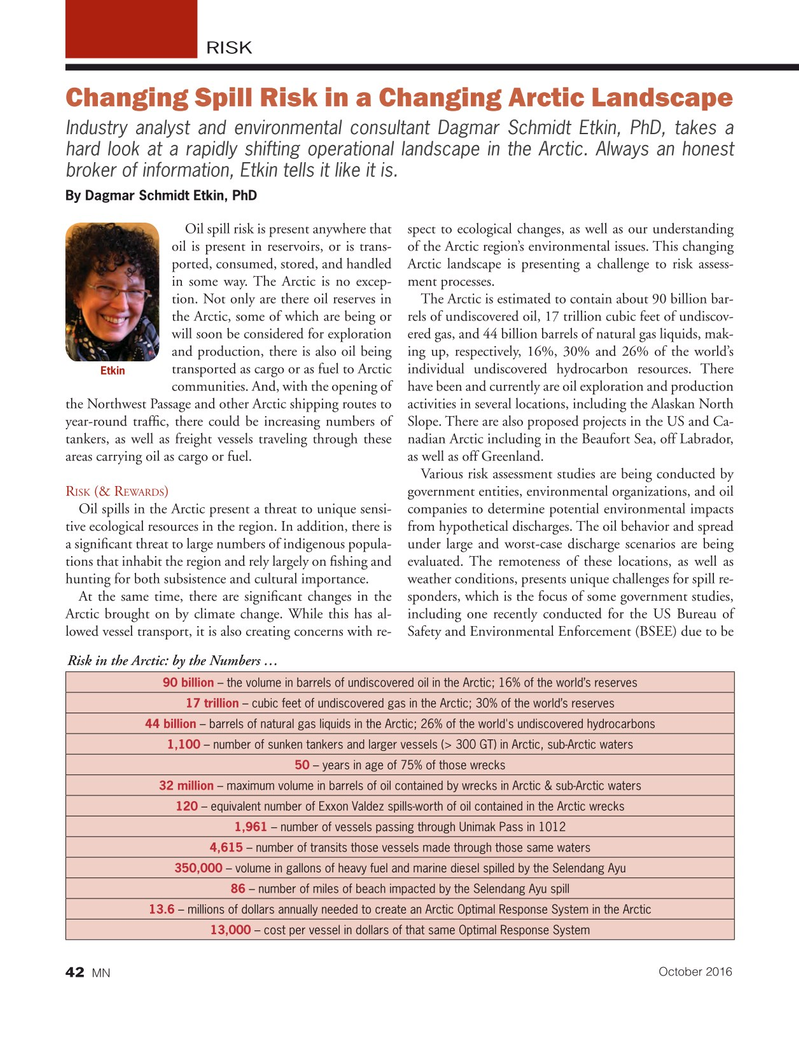
Page 42: of Marine News Magazine (October 2016)
Salvage & Spill Response
Read this page in Pdf, Flash or Html5 edition of October 2016 Marine News Magazine
RISK
Changing Spill Risk in a Changing Arctic Landscape
Industry analyst and environmental consultant Dagmar Schmidt Etkin, PhD, takes a hard look at a rapidly shifting operational landscape in the Arctic. Always an honest broker of information, Etkin tells it like it is.
By Dagmar Schmidt Etkin, PhD
Oil spill risk is present anywhere that spect to ecological changes, as well as our understanding oil is present in reservoirs, or is trans- of the Arctic region’s environmental issues. This changing ported, consumed, stored, and handled Arctic landscape is presenting a challenge to risk assess- in some way. The Arctic is no excep- ment processes.
tion. Not only are there oil reserves in The Arctic is estimated to contain about 90 billion bar- the Arctic, some of which are being or rels of undiscovered oil, 17 trillion cubic feet of undiscov- will soon be considered for exploration ered gas, and 44 billion barrels of natural gas liquids, mak- and production, there is also oil being ing up, respectively, 16%, 30% and 26% of the world’s transported as cargo or as fuel to Arctic individual undiscovered hydrocarbon resources. There
Etkin communities. And, with the opening of have been and currently are oil exploration and production the Northwest Passage and other Arctic shipping routes to activities in several locations, including the Alaskan North year-round traf? c, there could be increasing numbers of Slope. There are also proposed projects in the US and Ca- tankers, as well as freight vessels traveling through these nadian Arctic including in the Beaufort Sea, off Labrador, areas carrying oil as cargo or fuel. as well as off Greenland.
Various risk assessment studies are being conducted by
R (& R ) government entities, environmental organizations, and oil
ISK EWARDS
Oil spills in the Arctic present a threat to unique sensi- companies to determine potential environmental impacts tive ecological resources in the region. In addition, there is from hypothetical discharges. The oil behavior and spread a signi? cant threat to large numbers of indigenous popula- under large and worst-case discharge scenarios are being tions that inhabit the region and rely largely on ? shing and evaluated. The remoteness of these locations, as well as hunting for both subsistence and cultural importance. weather conditions, presents unique challenges for spill re-
At the same time, there are signi? cant changes in the sponders, which is the focus of some government studies,
Arctic brought on by climate change. While this has al- including one recently conducted for the US Bureau of lowed vessel transport, it is also creating concerns with re- Safety and Environmental Enforcement (BSEE) due to be
Risk in the Arctic: by the Numbers … 90 billion – the volume in barrels of undiscovered oil in the Arctic; 16% of the world’s reserves 17 trillion – cubic feet of undiscovered gas in the Arctic; 30% of the world’s reserves 44 billion – barrels of natural gas liquids in the Arctic; 26% of the world's undiscovered hydrocarbons 1,100 – number of sunken tankers and larger vessels (> 300 GT) in Arctic, sub-Arctic waters 50 – years in age of 75% of those wrecks 32 million – maximum volume in barrels of oil contained by wrecks in Arctic & sub-Arctic waters 120 – equivalent number of Exxon Valdez spills-worth of oil contained in the Arctic wrecks 1,961 – number of vessels passing through Unimak Pass in 1012 4,615 – number of transits those vessels made through those same waters 350,000 – volume in gallons of heavy fuel and marine diesel spilled by the Selendang Ayu 86 – number of miles of beach impacted by the Selendang Ayu spill 13.6 – millions of dollars annually needed to create an Arctic Optimal Response System in the Arctic 13,000 – cost per vessel in dollars of that same Optimal Response System
October 2016 42
MN
MN Oct16 Layout 32-49.indd 42 9/21/2016 3:26:53 PM

 41
41

 43
43
